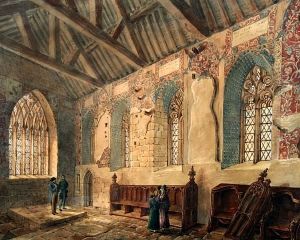Robert Dennis Chantrell Paintings
Robert Dennis Chantrell was a British architect, known primarily for his work in the Gothic Revival style. Born on February 4, 1793, in Somerset, England, Chantrell was educated at the prestigious Royal Academy Schools in London. His early career was influenced by the Gothic Revival movement, which sought to revive medieval Gothic architecture and was a reaction against the neoclassical styles prevalent at the time.
Chantrell worked as an assistant to the notable architect John Soane before establishing his own practice. He gained significant recognition for his work on religious buildings, particularly churches. One of his most famous works is the Leeds Parish Church, now known as Leeds Minster, completed in 1841. This project exemplified his ability to blend historical accuracy with the needs of contemporary worship, and it is considered one of the finest examples of Victorian Gothic architecture.
Throughout his career, Chantrell remained committed to the principles of the Gothic Revival. He was a meticulous researcher of medieval architecture, which allowed him to design buildings that were not only visually appealing but also historically informed. He also wrote on architectural subjects and was active in several professional societies, including the Royal Institute of British Architects (RIBA).
Chantrell's other notable projects include the restoration of Ripon Cathedral and the design of numerous other churches across England. His work was characterized by a strong attention to detail, use of high-quality materials, and an understanding of the structural and aesthetic principles of Gothic architecture.
Robert Dennis Chantrell passed away on January 5, 1872. His legacy lies in the churches and buildings he designed, many of which continue to be appreciated for their architectural significance and contribution to the Gothic Revival movement in Britain.
